MINDORO’S CAPTURE IS STEPPING STONE TO MANILA
Mindoro Island, Philippines • December 15, 1944
On October 17, 1944, the naval, air, and land forces of Gen. Douglas MacArthur, Supreme Commander, Southwest Pacific Area, began their assault on the Japanese-held Philippine island of Leyte. Three days later MacArthur and his staff, accompanied by Philippine president Sergio Osmeña, waded onto Palo Beach (Red Beach), where the general famously fulfilled his promise to the Philippine people: “I shall return.” But, of course, in MacArthur’s mind, his pledge would not really be realized until he reentered Manila, the Philippines’ capital on Luzon, the largest, most populous, and most important island in the the Philippine archipelago (see map), from which he and a small party of Americans and Filipinos had escaped on March 11, 1942.
As the battle for Leyte Island was reaching its declared climax a day after Christmas, MacArthur opened preparatory moves for the assault on Luzon by unleashing amphibious landings on Mindoro Island, which occurred on this date, December 15, 1944. The battle for Mindoro, which ended the next day, captured airfields that were much better positioned than those on Leyte for fighter strikes on Luzon Island and B‑24 Liberator attacks on Japanese shipping off Luzon’s coast and in the South China Sea; two bases were ready for their new assignments within 13 days. Mindoro was also seen as an advanced base for U.S. troops being primed for an assault on Manila, less than 100 miles to the north.
The initial Mindoro landing was unopposed by the 1,000‑man Japanese garrison augmented by 200 shipwreck survivors, largely because Japanese general Tomoyuki Yamashita, in charge of the defense of the Philippine archipelago, was caught by off guard: he had poured men and resources into the defense of Leyte less than three months before and was gearing up to do the same on Luzon. For a loss of 18 Americans and 81 wounded, the outnumbered and outgunned Mindoro defenders suffered around 200 killed, 375 wounded, and 15 captured. Enemy survivors fled into the island’s jungle-covered hills and mountains, where they stayed through the end of the war.
In early January 1945 an armada of nearly 1,000 U.S. and Australian warships and landing craft were taking up positions in Lingayen Gulf on the southwestern side of Luzon Island. Over three years before the same gulf had provided the landfall for Lt. Gen. Masaharu Homma’s Japanese 14th Army, which went on to seize the Philippines and capture the last American outpost, Corregidor, on May 6, 1942. Now on January 9, 1945, after devastating naval and carrier bombardments, roughly 68,000 soldiers of Lt. Gen. Walter Krueger’s U.S. 6th Army, plus MacArthur and four senior members of his staff, landed on the same coast, followed by 135,000 more over the next few days, establishing a 20‑mile beachhead 5 miles deep and a huge supply depot for the rest of the war. Three weeks later U.S. and Filipino forces stood at the gates of Manila. The city’s liberation after a monthlong struggle in which an estimated 100,000 residents were killed by both sides (February 3 to March 3, 1945) was the keystone in MacArthur’s victory over the Japanese invaders.
![]()
The Philippines and the Chief Areas of Conflict in 1944–1945: Leyte, Mindoro, and Luzon Islands
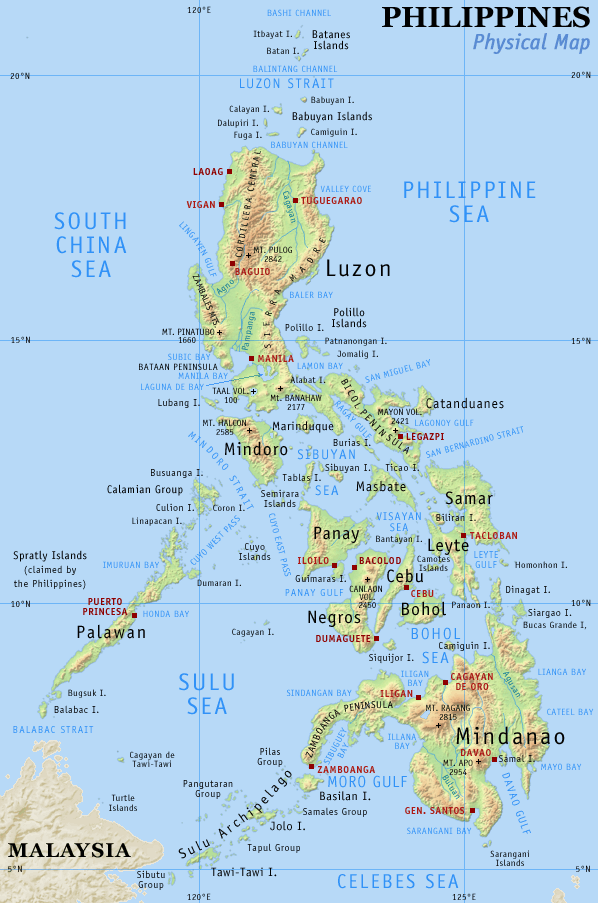 |
Above: Map of the Philippines showing the location of Leyte Island on the eastern side of the Philippine archipelago, close to its middle, and the islands of Mindoro (seized on December 15–16, 1944) and Luzon northwest of Leyte. Lingayen Gulf is on the southwestern side of Luzon, where on January 9, 1945, Lt. Gen. Walter Krueger’s U.S. 6th Army landed (see photos below) to confront 287,000 island defenders. The landings had been preceded by a three-day naval and air bombardment. By July 1, almost 6 months later, the 6th Army reported 173,000 Luzon defenders dead.
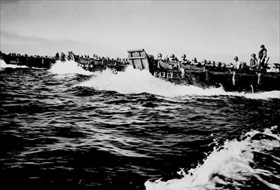 | 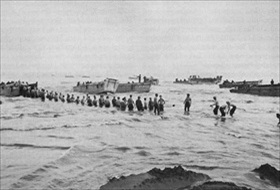 |
Left: While naval units raked the shore with intense covering fire, landing craft loaded with U.S. 6th Army assault troops begin moving in toward Luzon’s Lingayen Gulf beaches, January 9, 1945. A total of 203,608 soldiers eventually landed over the next few days and quickly captured the coastal towns. Theirs was the largest amphibious invasion ever undertaken in the Pacific Theater until Okinawa (April 1 to June 22, 1945). With ancillary landings near Manila in late January, the Luzon campaign was the largest deployment of U.S. forces in the Pacific War.
![]()
Right: Men of a U.S. 6th Army unit line up in the surf, passing ammunition onto a Lingayen beach, Luzon, January 9, 1945, three days after the appearance of the first Allied naval elements in Lingayen Gulf.
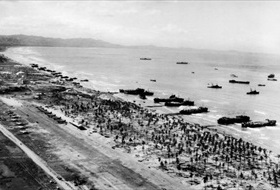 | 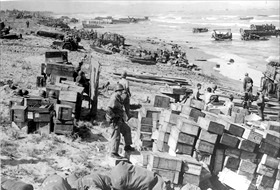 |
Left: An aerial view of American landing ships and forces during the invasion of the Lingayen Gulf, Luzon, January 1945. On the 13th MacArthur established his first field headquarters on Luzon in a school building at Dagupan, a town near one of the gulf invasion beachheads, before moving it inland on January 25.
![]()
Right: A view of the landing beaches and supply dumps, Lingayen Gulf, January 1945. Lingayen’s wide beaches were turned into a huge logistics depot for equipment and supplies for the rest of the war to support the Battle of Luzon (January 9 to August 15, 1945). Indeed, MacArthur viewed the entire archipelago as a gigantic base for anti-Japanese operations, particularly to the south into Borneo, with its Balikpapan oil fields, the second-largest oil center in the East Indies, and further south into the Dutch East Indies.
Newsreel Footage of Gen. Douglas MacArthur’s Forces Liberating Luzon Island and Philippine Capital Manila, January–March 1945
![]()

 History buffs, there is good news! The Daily Chronicles of World War II is now available as an ebook for $4.99 on Amazon.com. Containing a year’s worth of dated entries from this website, the ebook brings the story of this tumultuous era to life in a compelling, authoritative, and succinct manner. Featuring inventive navigation aids, the ebook enables readers to instantly move forward or backward by month and date to different dated entries. Simple and elegant! Click
History buffs, there is good news! The Daily Chronicles of World War II is now available as an ebook for $4.99 on Amazon.com. Containing a year’s worth of dated entries from this website, the ebook brings the story of this tumultuous era to life in a compelling, authoritative, and succinct manner. Featuring inventive navigation aids, the ebook enables readers to instantly move forward or backward by month and date to different dated entries. Simple and elegant! Click 











